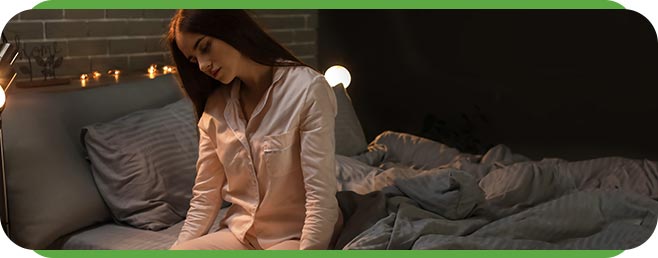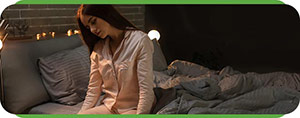Sleepwalking: What Is Somnambulism?
Sleepwalkers experience blurred vision or semi-consciousness, reacting to stimuli but lacking face recognition or meaningful interaction. Their eyes appear glassy or unfocused, indicating a lack of connection with their surroundings. Research indicates that individuals with depression, anxiety, alcohol use disorder, and obsessive-compulsive disorder are more likely to experience sleepwalking episodes. If you or someone you know is suffering from sleepwalking, visit our professionals at Koala® Center For Sleep & TMJ Disorders. For more information, please contact us or book an appointment online now! We have convenient locations across the USA in Bloomington IL, Peoria/Dunlap IL, El Paso TX, and Wausau WI.




Table of Contents:
Why should you not wake up a sleepwalker?
Is there a way to stop sleepwalking?
Can sleepwalkers see you?
How many people suffer from sleepwalking?
Get answers for your sleepwalking questions at Koala® Center For Sleep & TMJ Disorders
Waking a sleepwalker may not always be as dangerous as commonly believed, but it can still lead to confusion, anxiety, or aggression. Sleepwalking, a type of sleep disorder known as somnambulism, typically occurs during the deep, non-rapid eye movement (NREM) stages of sleep. Sleepwalking episodes usually happen within the first few hours after falling asleep.
If abruptly woken up, a sleepwalker may not recognize their surroundings or fully understand what is happening, leading to disorientation and unpredictable reactions. Instead of waking a sleepwalker, it’s safer to gently guide them back to bed without rousing them. If they need to be moved for safety, do so with minimal interaction and in a way that is likely to keep them in their sleep state to prevent confusion or aggression.
While there is no specific treatment for sleepwalking, healthcare professionals recommend several steps to reduce the frequency and potential risk associated with sleepwalking episodes. These include:
Stress management techniques – Lowering your stress levels may lower the frequency of sleepwalking episodes. You can try relaxation techniques, stress management strategies, or mental health therapy to lower your stress levels.
Scheduled waking – Waking the person about 15 to 30 minutes before their episodes typically start can help prevent these occurrences from happening.
Treatment of other disorders – Addressing underlying conditions is important for limiting sleepwalking. For example, receiving treatment for obstructive sleep apnea, which disrupts sleep and can trigger sleepwalking, can reduce the frequency of your sleepwalking episodes.
Medication – There is no specific medication to cure sleepwalking, but in some cases, medications that influence neurotransmitter levels may be prescribed to manage this condition.
In addition, healthcare professionals recommend practicing good sleep hygiene and prioritizing getting enough sleep to avoid sleep deprivation and frequent sleepwalking episodes. It’s essential to manage stress and avoid caffeine, alcohol, and other things that could impact your sleep quality.
Sleepwalkers, despite being physically active and moving about, are not truly conscious or aware. Their eyes may be open during a sleepwalking episode, and they may appear to be seeing and interacting with their surroundings, but sleepwalkers do not see or process visual information in the way people do when they are awake. Essentially, sleepwalkers may look awake, but they are not aware of their surroundings or their own movements.
The visual experience of a sleepwalker can be described as moving through a familiar space with extremely blurred vision or in a state of semi-consciousness. Sleepwalkers may react to stimuli, such as light or movement, but they do not have the ability to recognize faces or interact with others in a meaningful way. Furthermore, when you see a sleepwalker, you may notice their eyes have a glassy or unfocused appearance, indicating their lack of connection with their surroundings.
Somnambulism, or sleepwalking, is more common than many people realize. A comprehensive study found that about 3.6% of U.S. adults experience sleepwalking, which translates to millions of people. The study also discovered that the lifetime prevalence of sleepwalking occurred in 29.2% of cases. This means that many people are affected by sleepwalking, and episodes are often chronic.
Furthermore, researchers found that people with depression, anxiety, alcohol use disorder, and obsessive-compulsive disorder are significantly more likely to experience sleepwalking episodes. In addition, individuals taking SSRI antidepressants were also found to be much more likely to sleepwalk. This research highlights that somnambulism is linked to conditions affecting mental health.
If you or a loved one is affected by sleepwalking, it’s important to see a professional to understand how to reduce the frequency of episodes and ensure safety when they do occur. The dedicated healthcare professionals at Koala® Center For Sleep & TMJ Disorders can assess your concerns and develop a personalized management plan to ensure the right measures are taken to minimize the occurrence and severity of your sleepwalking incidents.
At Koala® Center For Sleep & TMJ Disorders, we understand that sleepwalking can be a concerning and potentially dangerous sleep behavior. We are here to provide the answers and solutions you need. Our expert team is dedicated to providing a precise diagnosis by identifying the root cause of your sleepwalking episodes, whether it is linked to an underlying sleep disorder, a medication, or another health condition. We offer a range of effective and personalized treatment options to help you restore a safe and peaceful night’s sleep, giving you and your family the peace of mind you deserve. Call us today to schedule your consultation with our providers.

Additional Services You May Need
▸ KoalaKIDZzz®
▸ Sleep Apnea
▸ Snoring
▸ TMJ Disorder
▸ Fatigue
▸ Sleep Disorders
▸ Weight Loss
▸ CPAP Alternative
▸ Oral Appliances




